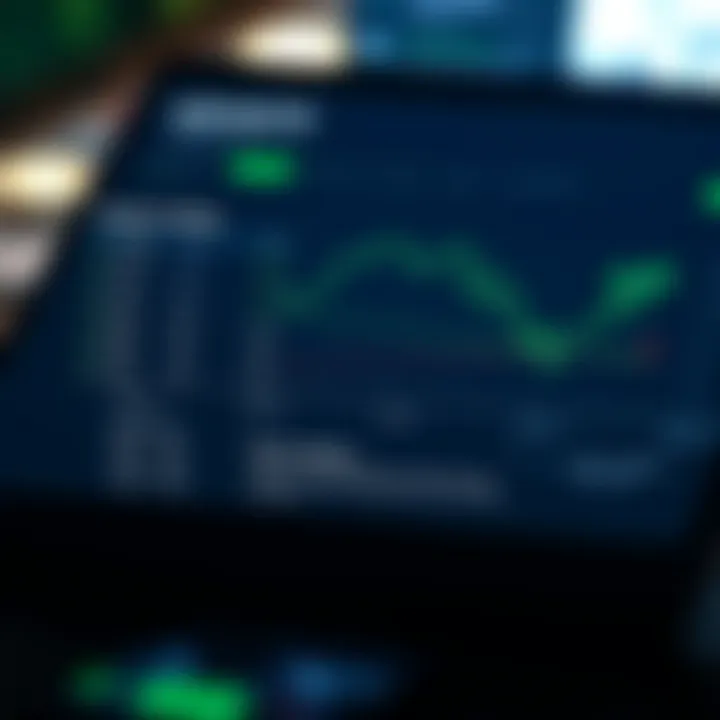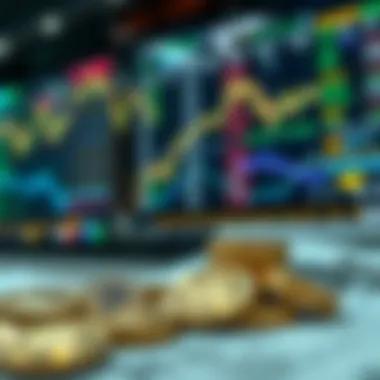Understanding Kraken Trade Fees: A Comprehensive Guide


Intro
Navigating the world of cryptocurrency trading can be akin to walking through a labyrinth. Among the many complexities, understanding trade fees on platforms like Kraken stands as a critical endeavor for traders and investors alike. These fees, while often perceived as mere costs associated with executing transactions, can significantly impact trading strategies and overall profitability.
Kraken, a long-standing player in the cryptocurrency exchange arena, offers a variety of features that make it appealing to both novices and seasoned traders. However, the intricacies of their fee structure can sometimes leave users scratching their heads.
This guide aims to cut through the confusion surrounding Kraken's trade fees. From elucidating different categories of fees to exploring how trading volume influences charges, we’ll navigate this terrain with clarity. Understanding these elements is not just beneficial; it’s essential for devising a smart trading strategy that maximizes returns while minimizing costs.
Understanding the current trends in cryptocurrency plays a pivotal role in shaping these fees. As market dynamics evolve, so do the structures that underpin trading costs. Thus, let’s dive into the current market trends and explore how they intertwine with the fees traders encounter in their day-to-day operations.
Prolusion to Kraken
The realm of cryptocurrency trading encompasses a myriad of exchanges, and Kraken stands out prominently among them. Understanding Kraken is pivotal to discerning its place in this fast-paced environment. It’s not just about diving headfirst into trades; having a solid grip on how this platform operates enhances one’s trading acumen.
In this segment, we recognize the significance of knowing what Kraken offers and how it maintains its user base. By familiarizing yourself with the exchange and its functionalities, you empower yourself to navigate the turbulent waves of crypto trading more effectively.
Overview of the Exchange
Kraken first emerged on the scene in 2011, establishing itself as one of the pioneering cryptocurrency exchanges. It boasts a wide range of cryptocurrencies – from stalwarts like Bitcoin and Ethereum to emerging altcoins. This variety attracts a diverse user base, making it a choice platform for both rookie and seasoned traders.
What sets Kraken apart is not only its extensive list of supported assets but also its robust trading tools. The interface is user-friendly, yet it also packs in sophisticated features for advanced trading. Factors like leverage offerings and futures trading enhance its appeal to traders looking to amplify their returns.
It’s also worth noting that Kraken is known for its strong security measures. This is crucial for safeguarding assets in a world where cyber threats are rampant. Users can feel a sense of reassurance knowing that the exchange employs a variety of security protocols, ensuring a secure trading environment.
Reputation and Trustworthiness
In the cryptocurrency exchange landscape, trust is paramount. Kraken has made considerable strides in establishing a solid reputation. From transparent operations to rigorous security practices, the giants in this space are often evaluated based on user experience, and Kraken ticks many of those boxes.
A key aspect of its reputation is its commitment to compliance and regulations. Kraken has registered with various financial authorities, regularly aligning itself with industry standards. It’s noteworthy that Kraken has, at times, faced scrutiny, but its ability to respond with transparency has bolstered its trustworthiness.
The exchange also actively engages with its community through various channels, like forums and social media platforms. This level of communication not only fosters a healthy user base but also allows for feedback loops, aiding in continuous improvement.
"Trust is built over time, and Kraken has shown dedication to maintaining integrity in its operations."
In essence, understanding Kraken means recognizing a platform that does not shy away from responsibility. Traders can embark on their cryptocurrency journey with more confidence when they know they are navigating a reputable exchange.
Kraken's Fee Structure Explained
Understanding Kraken's fee structure is vital for anyone looking to trade effectively on this platform. In today’s fast-paced trading environment, knowing how fees are calculated can make a considerable difference to your overall profitability. As a trader, whether you’re a day trader or an investor holding assets long-term, every dollar counts. The nuances of fees can dictate the viability of deploying certain trading strategies. Being aware of how these fees potentially affect your returns enables you to formulate better strategies and make informed decisions.
Trading Fees
Trading fees are the lifeblood of any cryptocurrency exchange, Kraken included. These fees vary between maker and taker orders. In essence, a maker adds liquidity to the market by placing an order that isn’t immediately matched. A taker, on the other hand, removes liquidity by executing a trade that matches an existing order. Understanding this distinction is crucial as it impacts the fees you are charged.
Kraken utilizes a tiered fee structure based on your 30-day trading volume. Higher trading volumes lead to lower fees, offering a clear incentive for active traders. For instance, trading pairs such as BTC/USD or ETH/USD might have distinct fees compared to more obscure altcoin pairs. The table below illustrates common trading fee percentages for each tier:
| 30-Day Volume | Maker Fee | Taker Fee | | Below $50,000 | 0.16% | 0.26% | | $50,000 - $100,000| 0.14% | 0.24% | | $100,000 - $1M | 0.12% | 0.22% | | Over $1M | 0.00% | 0.10% |
This tiered structure means that if you're actively trading or managing a larger portfolio, you can expect to see significant savings. Engaging in sharp practices can feel akin to stepping on a rollercoaster—the highs are beyond thrilling when you’re making significant profits, but the lows on fees can be hard to swallow.
Withdrawal and Deposit Fees
When it comes to managing your funds, understanding withdrawal and deposit fees is equally crucial. Kraken allows various methods for deposits, including bank transfers and cryptocurrency deposits. However, each of these methods comes with its own set of fees. Often, it’s bank transfers that are free, while credit card deposits might incur a processing fee.


For withdrawals, the fees can vary based on the cryptocurrency you choose to withdraw. For example:
- Bitcoin Withdrawals - a flat fee of 0.0005 BTC.
- Ethereum Withdrawals - a fee of 0.005 ETH.
- XRP Withdrawals - a mere fee of 0.02 XRP.
"Not all fees are outright visible at first glance. Understanding them can save you from unexpected costs down the line."
It’s essential to regularly check Kraken’s fee page for the most current withdrawal and deposit fees, as these can change over time based on network conditions or Kraken's policies.
Fee Tiers Based on Volume
The fee tiers based on trading volume reinforce the importance of actively trading through Kraken. By engaging higher volumes of trades, you dip into lower fee categories. This notion can transform your trading profitability from a struggle into a breeze.
To elaborate, if you frequently trade under $50,000 in a month, you might not get the best bang for your buck with a 0.26% taker fee. However, by increasing your trading volume, you can slip into the next tier and save 0.02% off that fee—which can add up, especially if you're making several trades a day.
At a glance, here’s how trading volume interacts with fees:
- Low volume might be suitable for beginners testing the waters.
- Mid-tier traders who hit the $100,000 mark enhance their trading edges significantly.
- High-volume traders can enjoy the lowest fees, allowing bigger margins for profit.
In summary, knowing where you stand in these tiers can influence your trading decisions, urging you to adapt your style for the sake of efficiency and cost-effectiveness. Use this knowledge as a tool to not just participate but thrive in the dynamic environment that Kraken offers.
Types of Trading Fees
Understanding the types of trading fees on the Kraken exchange is crucial for any trader looking to maximize their investments. These fees can directly impact your profit margins and influence your overall trading strategy. Not all fees are created equal; knowing the differences between them can help you make better decisions in your trading journey.
Maker vs. Taker Fees
In the world of crypto trading, two fundamental fee types exist: maker fees and taker fees. The distinction between these two is vital because they cater to different trading strategies and interactions within the market.
Maker fees are applied to those transactions that provide liquidity to the trading order book. This means if you place a limit order, which eventually gets matched, you become a maker. This helps other traders by ensuring there are buy and sell orders available, fostering market depth and stability. Generally, maker fees tend to be lower than taker fees, as exchanges encourage liquidity providing activities.
Example: If you put in an order to buy Bitcoin at a specific price, and someone sells it at that price later, you’re a maker.
On the flip side, taker fees apply when you take liquidity out of the market by placing a market order or an order that matches with an existing one on the order book. This is a more immediate way of trading, but it usually comes with higher fees. Since you’re removing liquidity, exchanges charge a premium for that service.
Example: If you quickly buy Bitcoin at the current market price without waiting, you’ll incur taker fees.
This distinction is not just about what you pay; it's also about your trading style. If you're a long-term trader, focusing on making market-depth enhancing trades can save you money in the long haul. Conversely, if you're a day trader looking for rapid execution, understanding taker fees allows you to factor those into your strategy.
Cross-Exchange Fees
Cross-exchange fees present another layer in the trading fee structure. These are fees that may come into play if you decide to transfer your assets between different exchanges or to utilize arbitrage trading strategies. When trading on multiple platforms, potential costs can arise due to transfer fees or withdrawal fees from one exchange and deposit fees on another.
Transferring funds between exchanges often incurs network fees, which are not uniquely defined by the exchange itself but are based on the blockchain network's congestion level. This can greatly affect the timing of your trades and potential profits, especially if you're looking to take advantage of price differences on different exchanges.
Traders need to be particularly mindful of these cross-exchange fees. It may seem attractive to exploit pricing discrepancies, but if the costs of moving assets erode your profit margins, the endeavor may not be worth it.
"Cross-exchange trading can be a double-edged sword; reap profits smartly or risk getting cut by unexpected transfer costs."
To navigate these fees effectively, traders should:
- Research the withdrawal and deposit fees of exchanges they use frequently.
- Understand the current state of the blockchain for efficient transactions.
- Consider maintaining funds on the exchange for trading, only moving assets as needed to minimize costs.
In summary, recognizing the differences in type of trading fees can lead to better trading decisions. By understanding maker and taker fees, and being cautious with cross-exchange transactions, you can optimize your strategy and improve your returns.
Factors Influencing Kraken Fees


Understanding the factors that influence fees on Kraken is pivotal for traders and investors looking to optimize their activities. This platform, like many others in the cryptocurrency realm, has a fee structure influenced by various elements, often reflecting the dynamics of the broader market as well as individual trading behaviors.
Market Conditions
Market conditions play a significant role in shaping the trading fees on Kraken. These conditions encapsulate various economic indicators and investor sentiment, affecting everything from liquidity to volatility. When the market is bullish—characterized by rising prices—traders often exhibit increased activity. This frenzy can lead to tighter spreads but potentially higer fees, especially if the demand for certain trading pairs spikes. Conversely, during bear markets, heightened volatility can lead to wider spreads, impacting the cost structures in play.
- Liquidity: In times of higher market activity, the liquidity on Kraken improves. More buyers and sellers often mean lower fees due to competition amongst traders, but fees can also rise depending on how Kraken adjusts its pricing to maintain balance.
- Volatility: Sudden market shifts may compel Kraken to tweak its fees. If traders react rapidly, the order book may not keep pace, leading to increased taker fees as traders hastily execute their trades to avoid losses.
Additionally, factors such as regulatory changes and geopolitical events also affect market conditions. For instance, news about legislation in major economies can drastically impact trading activity and, subsequently, the fees charged. It’s a poignant reminder that fees are not static; they ebb and flow based on numerous external influences.
Trading Volume
Trading volume is another critical element that can directly impact fees on Kraken. The volume is effectively a measure of how much cryptocurrency is being traded over a specific period. Higher trading volumes directly correlate with lower transaction fees, primarily because Kraken implements a tiered fee structure, which incentivizes higher trading activity.
For example, if a trader consistently hits the thresholds set by Kraken for higher trading tiers, they stand to gain reduction in their fees. Here’s how the structure typically functions:
- Low Volume Traders: Those who trade less may find themselves in higher fee brackets, leading to less favorable experiences.
- High Volume Traders: Conversely, high volume users can enjoy discounts, promoting increased trading and loyalty to the platform.
In effect, trading volume is an essential consideration for anyone engaging with the Kraken platform. Traders should keep a keen eye on their activity levels and volume trends, as impacting their fee status can enhance their overall profitability.
"If you want to swim with the big fish, you’ve got to learn to dive deep. In trading, that often means managing your volume to optimize fees."
Both market conditions and trading volume are just a couple of the levers that influence fees on Kraken. Smart traders should stay informed about current market sentiments and consistently assess their trading volume to make the most of their trading strategies.
Comparative Analysis with Other Exchanges
When it comes to trading cryptocurrencies, understanding fees is crucial for anyone hoping to maximize their returns. The ability to compare fees across various exchanges can genuinely tilt the scales in favor of a savvy trader. Kraken, being one of the more established platforms, offers a fee system that, on the surface, may seem straightforward. However, comparing it with competitors like Binance and Coinbase sheds light on details that could dramatically affect a trader's profitability.
Fee Comparison with Binance
Binance has gained a reputation for its competitive fee structure, often considered one of the lowest in the industry. For instance, while Kraken operates on a tiered system based on 30-day trading volume, Binance additionally offers nominal fees that can be reduced even further by using its native token, BNB, for transaction costs. This means that a user actively trading can enjoy even lower fees simply by holding Binance’s tokens.
- Basic Maker fee: Kraken starts at 0.16%, whereas Binance's base fee is 0.10%.
- Taker fee comparisons: On Kraken, the starting point is 0.26%, compared to Binance’s 0.20%.
These seemingly small differences can accumulate significantly as a trader's volume increases. In the high-stakes world of trading, every basis point counts. Furthermore, Binance tends to offer more frequent promotions and incentives, allowing traders to minimize their costs even further. Analyzing these differences can help a trader gauge the real cost of conducting trades and potential savings.
Fee Comparison with Coinbase
On the other end of the spectrum, Coinbase is notorious for its higher fees, often resulting in sticker shock for new users. Their fee structure includes both a spread and a flat fee, depending on the amount being traded, which can lead to a lack of transparency. Kraken’s model, in contrast, is far more predictable:
- Flat fees at Coinbase can range from $0.99 to $2.99 in addition to a variable spread of about 0.5%. In comparison, Kraken's fees remain lower and are much clearer.
- For larger trading volumes, Kraken’s tiered approach typically results in lower fees compared to Coinbase, especially for active traders.
This analysis clearly underscores the importance of understanding how trade fees can impact one’s overall trading strategy. With Coinbase's fees potentially eating away at profits, Kraken could appeal more to those looking to trade at a higher volume or frequently
"A penny saved is a penny earned." - Benjamin Franklin
In summary, when dissecting the fee structures of Kraken in relation to its competitors, it’s evident that traders need to look beyond just the numerical values. Each exchange has its unique selling propositions, and what works best will ultimately depend on individual trading practices and preferences. Always weigh your options carefully, as even the slightest adjustments in fees can have profound effects on your trading outcomes.
Impact of Fees on Trading Strategies
In the world of cryptocurrency trading, understanding fees is as vital as knowing the market itself. Fees can make or break a trader's strategy, influencing decision-making at every turn. Whether one is a steadfast long-term holder or a nimble short-term trader, the nature of fees on platforms like Kraken can significantly sway overall profitability. Getting a grasp on how fees operate allows traders to devise strategies that not only maximize returns but also minimize costs.
The effect of fees is felt directly in every trade. They act like a shadow, quietly consuming profits while making the trading environment more complex. Being unaware of your fee structure can lead to massive losses, turning what seemed like a lucrative position into a marginal gain or even a loss.
Long-Term Trading


For those who adopt a long-term strategy, where investment horizons often stretch over months or even years, understanding trade fees is essential. Although it may seem like fees would be less impactful over time, the reality is a bit more nuanced. Depending on how frequent the trades are, these fees can accumulate over time.
When executing trades for a longer duration, even small fees can compound, representing a sizable portion of a trader's returns. For instance, if you frequently trade a large volume, a seemingly insignificant trading fee can erode your profits. It’s prudent for long-term investors to consider using limit orders, which often come with lower fees, instead of market orders.
Additionally, considering the type of assets being traded is crucial. Some cryptocurrencies on Kraken might have higher withdrawal or trading fees. If a trader is planning to hold an asset for an extended period, it is logical to select those with lower fees to maximize profit margins.
"In the long haul, pennies saved turn into dollars made. A focus on fee structure is key to any successful strategy."
Engaging in regular evaluations of portfolio performance against fee impact will sharpen your edge. Tools such as calculators available on Kraken or third-party sites can help visualize this long-term fee effect, providing key insights that inform future strategies.
Short-Term Trading
Conversely, short-term trading strategies require a completely different evaluation of fees. Traders engaged in day trading, scalping, or other high-frequency tactics find the myriad of fees a crucial element to account for in their planning. With every rapid trade, every cent counts.
In these fast-paced environments, the goal is to seize smaller price changes that happen over short periods. Therefore, high fees have an outsized effect on net profits. A trader could execute dozens of trades in a single day, and if fees are high, this could translate into a significant chunk of cost eating away at potential profits.
To mitigate fee impacts in short-term trading, those involved often make use of Kraken’s fee tier structure, focusing specifically on trading a larger volume to benefit from reduced fees as mentioned earlier. A careful selection of trading pairs is also a game changer, as well as timing trades to avoid peak hours which can spike fees due to increased trading activity.
Keeping abreast of changing market conditions, as well as all associated fees, empowers short-term traders to adapt their strategies in real-time, reinforcing that fees are not merely a footnote in trading but a critical parameter to consider.
In summary, whether one’s strategy leans towards the long game or the quick score, understanding the layered effects of fees on trading strategies is vital. Smart traders utilize this knowledge to filter noise from data, crafting plans that harness their investment approaches efficiently.
Fee Optimization Strategies
In the ever-evolving world of cryptocurrency trading, savvy traders know that every penny counts. As such, understanding how to effectively manage and optimize fees can significantly impact overall profitability. This section focuses on fee optimization strategies that can help traders make the most of their time and investment on Kraken, thus turning potential losses from fees into profits.
Traders, investors, and analysts alike should carefully consider the strategies outlined below, as they provide methodologies to minimize expenses while maximizing potential returns.
Utilizing Fee Discounts
One of the easiest avenues for fee optimization lies in taking advantage of discounts that Kraken offers. By employing specific strategies, traders can reduce their trading costs, making a substantial difference in their overall financial success. Here are several methods to securing those vital fee reductions:
- Volume-Based Discounts: Kraken operates a tiered fee structure, meaning that the more a trader engages in buying and selling, the lower their fees can become. By carefully planning trading activities or accumulating a number of trades within a given time frame, one can shift into a lower fee tier.
- Holding Kraken's Native Token: Use Kraken’s native token, known as KRAK, if available. Some platforms offer reduced fees for users who hold their tokens, ultimately allowing traders to cut down on costs when executing trades.
- Referral Programs: Sharing the platform with others can be mutually beneficial. Many exchanges, including Kraken, offer referral programs that reward both the referrer and the new user by providing discounts on fees. A win-win scenario!
Choosing the Right Trading Pair
Selecting the appropriate trading pair can be a game-changer for optimizing fees. Not all trading pairs have the same fees, and understanding how to navigate these options can lead to significant savings. Here’s how to strategically choose the right pair:
- Analyze the Fee Structure of Pairs: Different currency pairs may have different fee rates. For example, trading a major cryptocurrency like Bitcoin against Ethereum might incur fewer fees than trading niche altcoins. Prioritize pairs that have lower fees to maximize your returns.
- Consider Liquidity Levels: Pair selection isn't just about fees; liquidity plays a key role as well. Higher liquidity can lead to tighter spreads, which effectively lowers the overall cost. Always look for trading pairs with substantial market activity that can drive down costs associated with market orders.
- Stay Updated on Market Changes: Cryptocurrency markets are quite dynamic. As new trading pairs are listed, or as the trading volumes of existing pairs fluctuate, so too might their fee structures. Keeping a finger on the pulse of these changes can help traders make timely decisions that save on costs.
By leveraging fee discounts and strategically selecting trading pairs, traders can optimize their experience on Kraken significantly. Understanding the nuances of fee structures and taking proactive measures to mitigate costs can provide traders with a competitive edge in an already challenging market.
Finale
In wrapping up our exploration of trade fees on the Kraken exchange, it's crucial to recognize the far-reaching impact these fees have on traders and investors alike. Whether you're a seasoned crypto enthusiast or just dipping your toes into the turbulent waters of cryptocurrency trading, understanding the nuances of transaction costs can make a world of difference to your bottom line.
Final Thoughts on Trade Fees
To put it plainly, the fees associated with trading can either eat away at your profits or enhance your trading performance, entirely depending on how well you navigate this aspect of the platform. Kraken's trade fees are structured to reflect a fair balance between encouraging trading activity and maintaining the integrity of the market. By comprehending the maker and taker fees, as well as withdrawal costs, traders can better strategize their entries and exits, fostering a more profitable trading environment.
Furthermore, always keep in mind that these fees can be influenced by factors such as trading volume and market shifts. The more informed you are about how certain fluctuations can alter fees, the better prepared you will be for rapid market changes.
"Successful traders are not those who avoid fees; rather, they are those who integrate fee knowledge into their strategies."
Future Considerations in Fee Structures
Looking ahead, the landscape of trading fees in cryptocurrency exchanges is constantly evolving. As more traders join platforms like Kraken, we could see adjustments in fee structures to accommodate this growing user base. It’s not far-fetched to expect that Kraken might introduce new fee tiers or promotional structures that could potentially benefit specific segments of traders.
For instance, if you are a frequent trader, staying abreast of any changes or updates from Kraken can help you take action to optimize your fee expenditures. As the market grapples with innovation, regulation, and users' demands, keeping a finger on the pulse of fee modifications will be vital for your trading strategy.
In closing, understanding trade fees goes beyond merely knowing their costs—it's about leveraging this knowledge into actionable insights that could very well enhance your trading practices and overall profitability in the dynamic cryptocurrency space.







